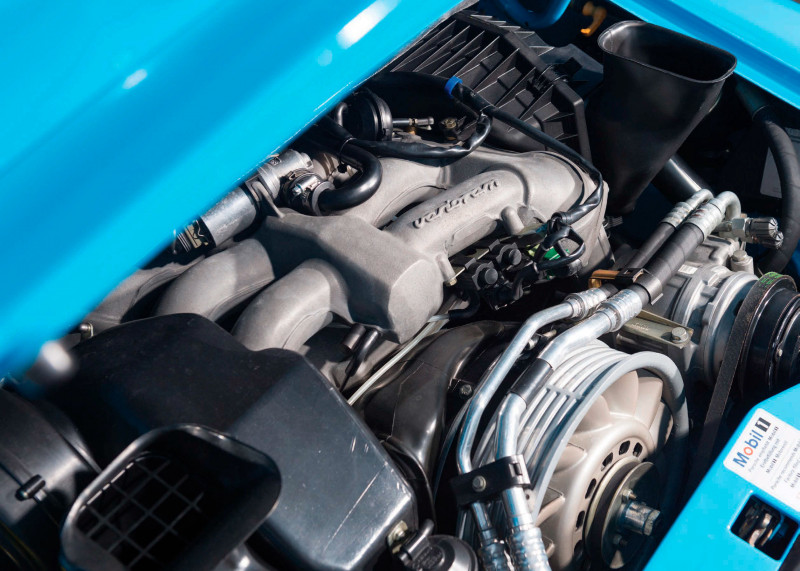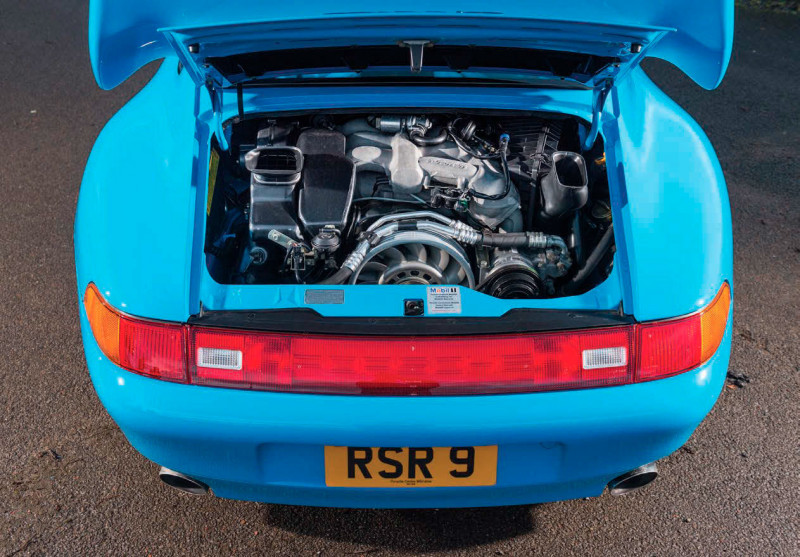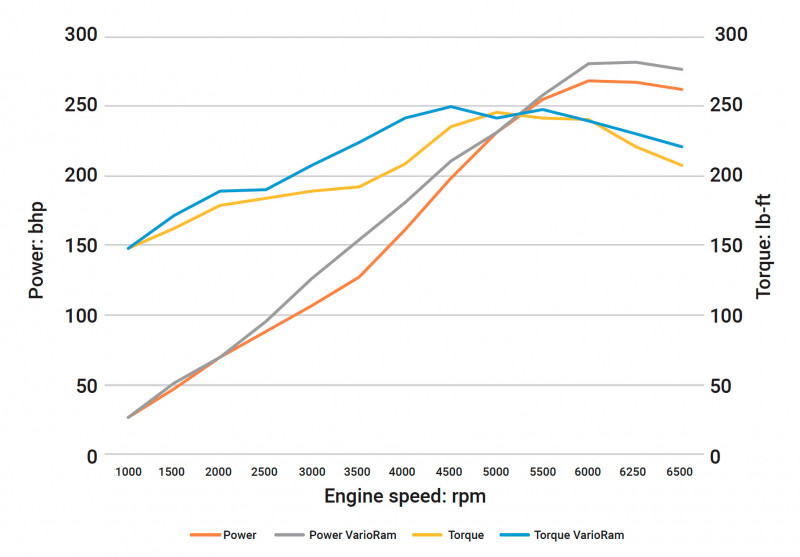Now we’re torquing! VarioRam variable induction explained.

Porsche’s patented VarioRam system is an ingenious way to alter geometry of the induction manifold according to engine needs under different operating conditions. Here’s how it works…
Words Shane O’Donoghue
Photography Adrian Brannan
NOW WE’RE TORQUING
VarioRam is the name Porsche gave to its advanced variable intake system when the technology was first released in 1994. It’s clear, however, from the wealth of Porsche-filed patents in the years leading up to then, that the manufacturer’s engineers had long considered the benefits of varying intake geometry. Indeed, the VarioRam system was preceded by a far simpler variable design that didn’t get much recognition, never mind a catchy marketing name. Before we look at how these Porsche systems work, it’s probably worth us going through an overview of intake tuning. This is a massive field of study, obviously, because it includes the whole inlet system, from engine air intake, filter, throttle and then the plenum, manifold and, finally, the inlet valves. Each and every millimetre of this system affects the tuning and performance of the host engine across the rev range.

When we say tuning, really, what we’re interested in here is volumetric efficiency. This is the measure of how much air — in terms of mass — you can get into an engine’s cylinder, compared with the theoretical amount. More air in the cylinder means it’s possible to burn more fuel, which translates into more energy released in a given combustion cycle. This equates to more torque at the crankshaft. Simply put, higher volumetric efficiency equals more torque and, because output is directly proportional to the torque, power. It’s easy to exceed one hundred percent volumetric efficiency in a turbocharged engine — the compressor lives up to its name and compresses air before it is fed into the cylinder, but in a normally aspirated engine, it takes a little more effort to achieve high levels of volumetric efficiency.

Inertia charging (or scavenging of the cylinder) is one technique. Using valve timing, a pressure wave in the exhaust is created that then scavenges the cylinder and draws the intake air in quicker. Some gases can flow back into the cylinder from the exhaust, too, meaning the potential for more air trapped for combustion and an increase in volumetric efficiency. For the most part, this technique relies on the geometry of the combustion chamber and the valve timing, along with the inlet ports and the rest of the intake system, of course.
GETTING PULSES RACING
On the subject of the inlet ports, it’s worth touching on what happens to the air in the ‘runner’, which encompasses the length from the back of the inlet valve to the main plenum chamber in the inlet manifold. When the inlet valve is open during the induction stroke, air is rushing into the cylinder at high speed. When the valve closes, the air compresses itself against the back of the closed valve, causing a pressure pulse to travel back up the runner. When this high-pressure pulse reaches the opening into the plenum, it reflects back down the runner. If the pulse can be timed to return to the back of the inlet valve when it is opened (this may require movement of the wave up and down the runner a few times), then it can greatly increase the air taken into the cylinder andincrease the volumetric efficiency. Sadly, this useful effect is limited to a narrow speed range for a fixed runner length. Generally speaking, the longer the runner, the lower the engine speed at which it’s optimised for. This is sometimes referred to as vibrating tube charging.

Resonance charging is another tuning technique, and it’s particularly relevant to engines laid out in a vee or boxer configuration, where, crucially, the firing order alternates between cylinder banks. It’ll become clear why in a moment, but in this configuration, the inlet manifold features two distinct plenum chambers, each feeding air to a bank of cylinders. These plenums have an interconnecting pipe (or pipes, but it’s as easy to think of the setup as a single pipe) and the air flows into this system through a regular throttle valve.
Due to the air being sucked into cylinders on alternating sides of the engine, a forward and back pressure wave occurs within the pipe that connects the two plenums. The position of this pressure wave at any given moment depends on the geometry of the inlet manifold and the engine speed. At a certain speed, the pulsing of the air reaches what’s known as its natural frequency and resonance occurs. This means the pulse from one plenum to the other will be in phase with the intake strokes. In turn, this results in higher air pressure in the inlet ports when the inlet valves are open, leading to greater mass of air in the cylinder and, consequently, an increase in volumetric efficiency and torque.
The engine speed at which resonance occurs can be tuned by the geometry of the inlet manifold, but it’s always a compromise — there’s a very narrow rev band over which resonance is actually useful. And, of course, there’s also the potential downside of causing an unwanted negative air pressure pulse in an inlet port at another engine speed, which would dramatically reduce the volumetric efficiency (and therefore the torque output) at that point.
With all we’ve described in mind, it’s not difficult to envisage the advantages of an inlet system with variable geometry. Erwin Rutschmann, one of Porsche’s many talented engineers (you’ll find his name on dozens of patents), is credited with creating the first variableresonance inlet manifold for the company, as fitted to the 964’s 3.6-litre M64 engine. As described above, the M64 featured an air plenum on each side, connected by a wide pipe. The main air intake flowed into this interconnecting tube. Underneath this, however, was another pipe — effectively a resonance chamber — linking the two plenums. This pipe housed a butterfly valve that was opened or closed (depending on engine speed and load) by the car’s advanced Bosch Motronic M2.1 electronic engine management control unit. The valve stayed closed until the engine revved above 5,600rpm. This variability would have allowed Porsche to accept a less compromised intake system, resulting in higher torque across the entire rev range.
VarioRam took the idea much further, with more variability for the inlet geometry to optimise volumetric efficiency across a wider range of engine conditions. It varies both the runner length and the resonance in one cleverly packaged intake manifold system. As expected, intake air is fed to the manifold from the air filter, but airflow can enter via two separate butterfly throttle valves. The upper valve opens by varying amounts at all times, allowing air into the central plenum you can see atop an engine fitted with the VarioRam system. This distributes air to three top runners on each side of the engine, leading into what appear to be further plenum chambers, with lower runners connecting those to the cylinders. What you can’t see from the outside is that the top runners feed movable sections. These are vacuum-operated and computer controlled. At low engine speeds and loads, these moving parts seal the top runners to the lower runners, resulting in a much longer runner length, better suited to the creation of low-speed torque. At this stage, the rest of the manifold is redundant, and the aforementioned vibrating tube charging is key to the engine’s volumetric efficiency.
When engine speed reaches 5,160rpm and the throttle valve is more than fifty percent open, the movable sections retract to allow air from the top runners into the lower plenum chambers. The lower throttle valve also starts to open, increasing overall airflow to the engine. In this scenario, the runner length is much shorter, from the lower plenums to the cylinders, which is better suited to high-speed operation. Additionally, the two lower plenum chambers are interconnected, allowing resonance tuning to suit the given operating condition. As is the case with the 964’s flat-six, the VarioRam manifold features an extra resonance chamber (or interconnecting pipe/ tube) operated by a butterfly valve. Providing the throttle is more than fifty percent open, the valve is opened at 5,920rpm, altering the resonance frequency once more to allow higher volumetric efficiency as the engine homes in on its peak power point.
DEVASTATING DEBUT
The first engine to use VarioRam was that of the 993 Carrera RS, though this car’s 3,746cc flat-six (codenamed M64/20 and marketed as a 3.8-litre unit) was significantly different to the 3.6-litre boxer fitted to the same-generation Carrera and Carrera 4. For a start, the RS lump featured lighter pistons and rocker arms, along with larger intake valves made possible by a two-millimetre increase in bore diameter. Peak outputs of 296bhp at 6,500rpm and 262lb-ft torque at 5,400rpm are usefully higher than the 3.6-litre engine’s 268bhp and 243lb-ft (delivered at 6,100rpm and 5,000rpm respectively), the higher revs in the Rennsport befitting its remit in life.
A more important comparison can be made between early 993 engines and those introduced from 1996, the latter identifiable by engine codes starting with M64/21. These later engines received VarioRam as standard, though it didn’t drastically alter maximum output of the 3.6-litre engine: the newer units developed 282bhp at 6,250rpm and 251lb-ft at 5,250rpm. Those are useful gains, undoubtedly, though they don’t fully illustrate the benefits of the VarioRam system. After all, it isn’t designed to introduce a hike in performance, per se.
Rather, as explained earlier, VarioRam’s goal is to refine and improve torque output across the whole rev range. In fact, the 3.6-litre 993 engine equipped with VarioRam also received bigger valves, which would have enhanced the engine’s breathing, especially at the top end. Higher peak power is as much attributable to this update as much as anything else, though you might argue the change was encouraged by the flexibility of VarioRam in the first place. As you can see on the previous page, our chart highlighting the power and torque curves for the 993 engine with and without VarioRam reveals a great deal.
For example, the VarioRam engine produces considerably more torque, notably in the 2,500-4,500rpm range. This is where most owners spend their driving time, which is why a 993 with VarioRam feels significantly more responsive in everyday driving environments.
The beauty of VarioRam is that its benefits don’t come at the expense of top-end power — although the updated 993 weighed thirty kilograms more than its predecessor, the Carrera’s sprint from rest to 62mph dropped from 5.6 seconds to 5.4 seconds, with top speed increasing from 167mph to 171mph. Fuel consumption improved, too. What’s not to like?!
Well, packaging, weight and complexity, so it would seem. VarioRam was short-lived — the 996’s new watercooled flat-six reverted to a simpler variable resonance manifold. Of course, the breathing of the newer 911’s engine was improved with a four-valve head, while VarioCam (first introduced to the 968’s bulletproof three-litre inline-four) allowed variability in valve timing that made VarioRam all but redundant. Nonetheless, there’s no doubting lessons learned during the development of VarioRam, knowledge which went on to inform the design of intake systems for all normally aspirated Porsche engines from the 993 onward.

Above VarioRam was in production from the arrival of the 993 Carrera RS in 1995, meaning 993s assembled before this time won’t have the system installed.
This page Long intake paths at low revs resulted in a gain in torque, while short intake paths resulted in a gain of performance in the 993’s upper speed range.
Above VarioRam supplemented the resonance charging system introduced in model year 1989 by allowing the length of the 993’s intake manifold to be varied.
Above and below The very first engine to use VarioRam was the 296bhp M64/20 fitted to the 993 Carrera RS.
Engine speed Power Power VarioRam Torque Torque VarioRam
- 1000 26.8204 26.8204 147.5124295 147.5124295
- 1500 46.9357 50.95876 162.2636724 171.1144182
- 2000 69.73304 69.73304 179.2276018 188.8159097
- 2500 88.50732 95.21242 184.3905368 190.291034
- 3000 107.2816 126.05588 188.8159097 207.2549634
- 3500 127.3969 154.2173 192.5037204 224.2188928
- 4000 160.9224 181.0377 208.7300877 241.9203843
- 4500 198.47096 210.54014 235.282325 249.2960058
- 5000 230.65544 230.65544 245.608195 241.9203843
- 5500 254.7938 257.47584 241.1828222 247.8208815
- 6000 268.204 280.27318 240.44526 239.7076979
- 6250 266.86298 281.6142 221.2686442 230.11939
- 6500 261.4989 276.25012 207.9925255 221.2686442

